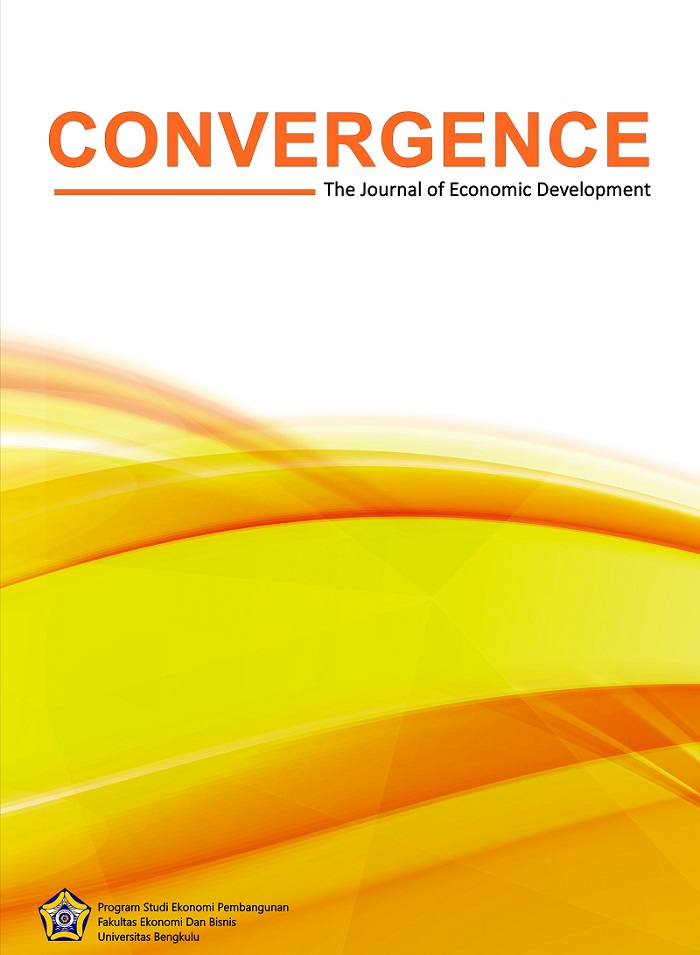Main Article Content
Abstract
The purpose of this research was to analyze palm oil on economic of Bengkulu Province. Base on BPS secondary and primary data, descriftive analysis was used to analyze the palm oil contribution on economic of Bengkulu Province. Land area of palm oil is more 50% than all of plantation land area in Bengkulu. The high productivity of CPO, palm oil is very potential commodity to increase Bengkulu economic. There are strong and positive correlation between palm oil land area with income disparities over the regent/city, the poverty rate, and income percapita. Activities of Palm oil plantation in 2022 relatively stable, but respondent predict will increase on Triwulan IV-2022. The respondent optimism made a prediction of labor absorption increase. Positive impact of the business on society welfare create by employment multipier and income multiplier effect.
Keywords: Palm oil, poverty.
Article Details
Copyright (c) 2023 Bertha Iin Esti Indraswanti

This work is licensed under a Creative Commons Attribution-ShareAlike 4.0 International License.
- This statement is a commitment from the author, to respect copyright, both in terms of quoting the work of others, as well as in the use of journal content.
- If needed, the author can send a statement of authenticity of the manuscript. With the receipt of an article by the Editor of Convergence: The Journal of Economic Development, the article submitted has the copyright held by Convergence: The Journal of Economic Development Convergence:
- The Journal of Economic Development has the right to reproduce and distribute articles that have been published in journals.
- The author is not permitted to publish the same article that has been published in this journal.
References
- Badan Pusat Statistik. 2018-2022. Provinsi Bengkulu Dalam Angka. Bengkulu.
- Badan Pusat Statistik. 2022. Statistik Kelapa Sawit.
- Fernandez, MG Noviarizal. 2021. Menghitung Besarnya Kontribusi Industri Sawit bagi Perekonomian Nasional. https://ekonomi.bisnis.com. Diunduh 30 Juni 2022.
- Hanafiah, Khayriyyah Mohd, Aini Hasanah Abd Mutalib, Priscillia M, Chun Sheng Goh, Shahrul Anuar MS, Nadine R. 2021. Impact of Malaysian Palm Oil on Sustainable Development Goals: co-benefit and trade-offs across mitigation strategies. Sustainability Science (2022) 17: 1639 – 1661. https://doi.org/10.1007/s11625-021-01052-4.
- Indriyadi, Wahyu. 2022. Palm Oil Plantation in Indonesia: A Question of Sustainability. Salus Cultura: Jurnal Pembangunan Manusia dan Kebudayaan, 2(1) 2022, pp. 1 – 10. https://doi.org/10.55480/saluscultura.v2i1.40.
- Isma. 2022. Industri Sawit Berperan Penting dalam Perekonomian Indonesia. infopublik.id. diunduh tanggal 28 Oktober 2022.
- Ishartono, S. T. R. (2019) “Sustainable development goals (SDGs) dan Pengentasan Kemiskinan,” Social Work Jurnal, volume.6(2). doi: 10.14512/gaia.28.2.1.
- Kuncoro, Mudrajad. 2011. Perencanaan Daerah: Bagaimana membangun ekonomi lokal, kota, dan kawasan. Salemba Empat. Jakarta.
- Pratama, Cahya Dicky. 2020. Indikator Keberhasilan Pembangunan Ekonomi. https://www.kompas.com/skola/read/2020/12/05/153626369. Diunduh tanggal 30 Oktober 2022.
- Purba, Jan Horas V dan Tungkot Sipayung. 2017. Perkebunan Kelapa Sawit Indonesia dalam Perspektif Pembangunan Berkelanjutan. Jurnal Masyarakat Pedesaan, Vol. 43 No. 1 Juni 2017.
- Shigetomi, Yosuke, Yuichi Ishimura dan Yuki Yamamoto. 2020. Trend in Global Dependency on The Indonesian Palm Oil and Resultant Environmental Impact. Scientific Reports (2020)10:20624. https://doi.org/10.1038/s41598-020-77458-4.
- Silitonga, Manaor. 2019. Peranan Sektor Agroindustri Kelapa Sawit Dalam Mendukung Perekonomian Sumatera Utara. Jurnal Ilmiah Kohesi. Vol. 3 No. 3 Juli 2019.
- Syukra, Ridho. 2021. Peran Industri Sawit pada Perekonomian Indonesia Belum Tergantikan. https://investor.id. Diunduh pada 28 Oktober 2022.
- https://bengkuluprov.go.id. Potensi Perkebunan Pertanian Bengkulu Dilirik Menteri Malaysia. Diunduh tanggal 28 Oktober 2022.
- https://kemenperin.go.id. 2022. Berdampak Luas bagi Ekonomi, Kemenperin Fokus Hilirisasi Industri Kelapa Sawit. Diunduh pada 28 Oktober 2022
- Wahyono, Teguh. 2008. Ekonomi Industri Kelapa Sawit di Indonesia serta Kaitannya dengan Program Penelitian dan Pengembangan. Jurnal Agro Ekonomi. Vol. 15. No. 1. Juni 2008. https://doi.org/10.22146/jae.18173. Diunduh pada 28 Oktober 2022.
References
Badan Pusat Statistik. 2018-2022. Provinsi Bengkulu Dalam Angka. Bengkulu.
Badan Pusat Statistik. 2022. Statistik Kelapa Sawit.
Fernandez, MG Noviarizal. 2021. Menghitung Besarnya Kontribusi Industri Sawit bagi Perekonomian Nasional. https://ekonomi.bisnis.com. Diunduh 30 Juni 2022.
Hanafiah, Khayriyyah Mohd, Aini Hasanah Abd Mutalib, Priscillia M, Chun Sheng Goh, Shahrul Anuar MS, Nadine R. 2021. Impact of Malaysian Palm Oil on Sustainable Development Goals: co-benefit and trade-offs across mitigation strategies. Sustainability Science (2022) 17: 1639 – 1661. https://doi.org/10.1007/s11625-021-01052-4.
Indriyadi, Wahyu. 2022. Palm Oil Plantation in Indonesia: A Question of Sustainability. Salus Cultura: Jurnal Pembangunan Manusia dan Kebudayaan, 2(1) 2022, pp. 1 – 10. https://doi.org/10.55480/saluscultura.v2i1.40.
Isma. 2022. Industri Sawit Berperan Penting dalam Perekonomian Indonesia. infopublik.id. diunduh tanggal 28 Oktober 2022.
Ishartono, S. T. R. (2019) “Sustainable development goals (SDGs) dan Pengentasan Kemiskinan,” Social Work Jurnal, volume.6(2). doi: 10.14512/gaia.28.2.1.
Kuncoro, Mudrajad. 2011. Perencanaan Daerah: Bagaimana membangun ekonomi lokal, kota, dan kawasan. Salemba Empat. Jakarta.
Pratama, Cahya Dicky. 2020. Indikator Keberhasilan Pembangunan Ekonomi. https://www.kompas.com/skola/read/2020/12/05/153626369. Diunduh tanggal 30 Oktober 2022.
Purba, Jan Horas V dan Tungkot Sipayung. 2017. Perkebunan Kelapa Sawit Indonesia dalam Perspektif Pembangunan Berkelanjutan. Jurnal Masyarakat Pedesaan, Vol. 43 No. 1 Juni 2017.
Shigetomi, Yosuke, Yuichi Ishimura dan Yuki Yamamoto. 2020. Trend in Global Dependency on The Indonesian Palm Oil and Resultant Environmental Impact. Scientific Reports (2020)10:20624. https://doi.org/10.1038/s41598-020-77458-4.
Silitonga, Manaor. 2019. Peranan Sektor Agroindustri Kelapa Sawit Dalam Mendukung Perekonomian Sumatera Utara. Jurnal Ilmiah Kohesi. Vol. 3 No. 3 Juli 2019.
Syukra, Ridho. 2021. Peran Industri Sawit pada Perekonomian Indonesia Belum Tergantikan. https://investor.id. Diunduh pada 28 Oktober 2022.
https://bengkuluprov.go.id. Potensi Perkebunan Pertanian Bengkulu Dilirik Menteri Malaysia. Diunduh tanggal 28 Oktober 2022.
https://kemenperin.go.id. 2022. Berdampak Luas bagi Ekonomi, Kemenperin Fokus Hilirisasi Industri Kelapa Sawit. Diunduh pada 28 Oktober 2022
Wahyono, Teguh. 2008. Ekonomi Industri Kelapa Sawit di Indonesia serta Kaitannya dengan Program Penelitian dan Pengembangan. Jurnal Agro Ekonomi. Vol. 15. No. 1. Juni 2008. https://doi.org/10.22146/jae.18173. Diunduh pada 28 Oktober 2022.
